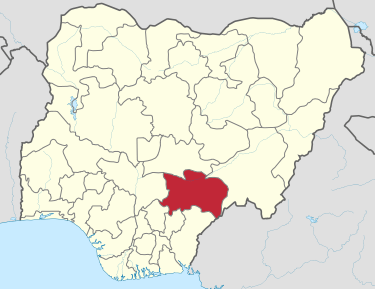Benue State

Benue State is one of the North Central states in Nigeria with a population of about 4,253,641 in 2006 census. It is inhabited predominantly by the Tiv, Idoma, Igede and Etulo peoples, who speak Tiv, Idoma, Igede and Etulo languages respectively. Its capital is Makurdi.[4] Benue is a rich agricultural region; popularly grown crops include; oranges, mangoes, sweet potatoes, cassava, soya bean, guinea corn, flax, yams, sesame, rice, groundnuts, and Palm Tree.
Benue State as it exists today is a surviving legacy of an administrative entity that was carved out of the protectorate of northern Nigeria at the beginning of the twentieth century. The territory was initially known as Munshi Province until 1918 when the name of its dominant geographical feature, the ‘Benue River’ was adopted.
Benue State is named after the Benue River and was formed from the former Benue-Plateau State in 1976, along with Igala and some part of Kwara State.[5] In 1991 some areas of Benue state (mostly Igala area), along with areas in Kwara State, were carved out to become part of the new Kogi State. Igbo people are found in the boundary areas like the Obi, Oju etc.
Samuel Ortom is the governor and Benson Abounu is the deputy governor. Both were elected under the All Progressives Congress (APC) but defected to the Peoples Democratic Party (PDP) in 2018.
The State, which is located in the North Central region of Nigeria, has a total population of 4,253,641 in 2006 census, with an average population density of 99 persons per km2. This makes Benue the 9th most populous state in Nigeria. However, the distribution of the population according to Local government areas shows marked duality.
There are areas of low population density, such as Guma, Gwer East, Ohimini, Katsina-Ala, Apa, Logo and Agatu, each with less than seventy persons per km2, while Vandeikya, Okpokwu, Ogbadibo, Obi and Gboko have densities ranging from 160 persons to 200 persons per km2 . Makurdi LGA has over 380 person per km2. The males are 49.8 percent of the total population while females constitute 50.2 per cent.
